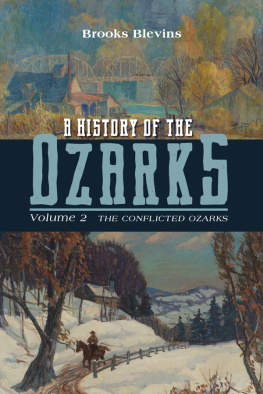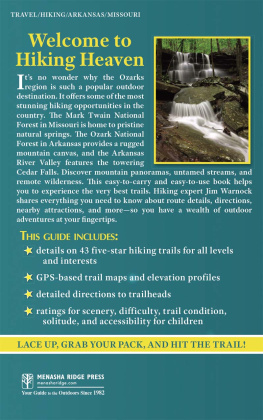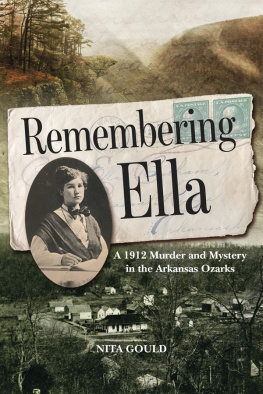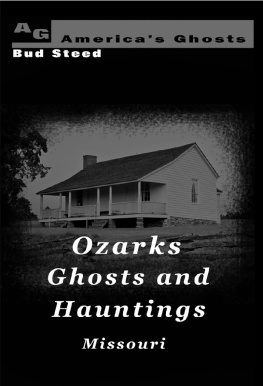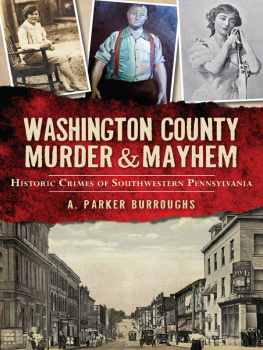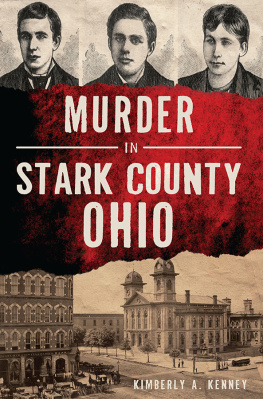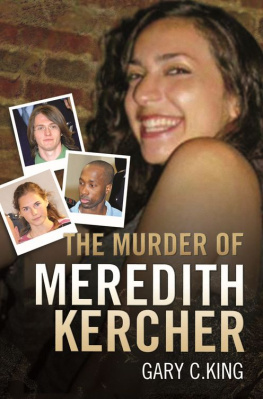GHOST OF THE OZARKS
GHOST
OF THE
OZARKS
Murder and Memory
in the Upland South
BROOKS BLEVINS
UNIVERSITY OF ILLINOIS PRESS
Urbana, Chicago, and Springfield
2012 by the Board of Trustees
of the University of Illinois
All rights reserved
Manufactured in the United States of America
C 5 4 3 2 1
 This book is printed on acid-free paper.
This book is printed on acid-free paper.
Portions of this book previously appeared in The Arkansas
Ghost Trial: The Connie Franklin Case and the Ozarks in the
National Media, Arkansas Historical Quarterly 68 (Autumn
2009): 127, and are reprinted here with permission.
Library of Congress Cataloging-in-Publication Data
Blevins, Brooks
Ghost of the Ozarks: murder and memory in the upland South /
Brooks Blevins.
p. cm.
Includes bibliographical references and index.
ISBN 978-0-252-03695-8 (hardcover: acid-free paper)
ISBN 978-0-252-09411-8 (ebook)
1. Franklin, Connie, 18971932. 2. MurderArkansas
Stone CountyHistory20th century. 3. Trials (Murder)
ArkansasStone County. 4. MurderPress coverageUnited
StatesHistory20th century. 5. ArkansasPress coverage
United StatesHistory20th century. 6. Ozark Mountains
RegionPress coverageUnited StatesHistory20th
century. 7. Stereotypes (Social psychology)United States
History20th century. 8. Collective memoryArkansasStone
CountyHistory20th century. 9. Stone County (Ark.)Social
life and customsHistory20th century. 10. Folklore
ArkansasStone CountyHistory20th century. I. Title.
HV 6533. A 8 B 55 2012
364.1523092dc23 2011034678
For Mom and Dad
Lindle and Carolyn (Trivitt) Blevins
Contents
Acknowledgments
I have never felt more intimidated by an acknowledgments section, for it seems as if I should be thanking just about everyone I have met over the past four and a half years. Though I alone should be held responsible for the story on these pages, and any errors inadvertently contained herein, this book would never have been possible without the generous assistance of dozens of people, from archivists, colleagues, and friends to descendants of many of the people whose stories enliven this book. Realizing that I will invariably leave out names that should be mentioned, I shall endeavor to thank those who helped over the course of researching and writing this book.
First mention goes to the many residents and former residents of Stone County, Arkansas, who made this book possible, from those who agreed to share their and their families stories in interviews to those whose informal chats directed me toward additional sources of information. Sam Younger, the only resident of St. James whom I knew before beginning this project, was my local tour guide and source of community history. I enjoyed those visits on the front porch and by the woodstove. Freda Cruse Phillips shared her familys stories and her deep love of Stone Countys lower end. During the early days of my research, fellow Lyon College employee Kay Stice, a Mountain View native who years ago had written a school project on the Connie Franklin mystery, generously provided me with Connie Franklin folklore and the names of Stone County contacts. Kays sister, Charlotte Lancaster Lawrence, and husband, Vernon Lawrence, always tolerated my unannounced drop-ins and questions at Lancasters Store on the Mountain View square with patience and helpfulness. Edwin Luther, the kind of local historian we all hope to encounter, went out of his way to track down information on more occasions than I can count. I could always depend on Freda Massey, Stone Countys preeminent genealogist, to reply promptly to my many queries for family background. Glenda Womack, a Stone County transplant and former volunteer at Mountain Views Stone County Heritage Museum, was extremely helpful and unfailingly generous with her time. The number of additional Stone Countians who provided leads, answered questions, and shared family stories are too numerous to mention, though a few more deserve recognition here: Stephanie Labert, Robbie Purdom, Ruth Clark, Dorothy Gayler, Junior Fulks, Jane Parker, Carole Donovan, James Dodson, Harry and Glenna Martin, Tina Meeker, Allen Baldridge, and the staffs of the Stone County Clerks Office and the Bessie Boehm Moore Memorial Library in Mountain View.
As with any project requiring scholarly historical research, archivists and librarians were invaluable. Among those whose assistance I could not have done without were Kimberly Harper, Lauren Leeman, and fellow staff members at the State Historical Society of Missouri; Jane Wilkerson, April Goff, Jane Hooker, and fellow staff members at the Arkansas History Commission; Brian Kelley at the University of Arkansass Mullins Library; Byron Stewart, Jim Coombs, and Nathan Neuschwander at Missouri State Universitys Meyer Library; David Richards, Anne Baker, and Tracie Gieselman-Holthaus at the Missouri State University Special Collections; Ed Frank at the University of Memphis Special Collections; and the entire staff of Lyon Colleges Mabee-Simpson Library: Dean Covington, Kathy Whittenton, Camille Beary, Brenda Lindsey, and Judy Blackwell. I also received valuable assistance from Twyla Wright and Amanda Nikkel at the Old Independence Regional Museum in Batesville, Arkansas; Vincent S. Anderson of the Donald W. Reynolds Library in Mountain Home, Arkansas; Steven Winick at the Library of Congresss American Folklife Center; Molly Dohrmann of the Special Collections and University Archives at Vanderbilt University; Barbara Rust of the Fort Worth branch of the National Archives and Records Administration; Jeremy Drouin of the Missouri Valley Special Collections at the Kansas City Public Library; Charlotte McIntosh at the Midwest Genealogy Center in Independence, Missouri; Carolyn Shaver at the Thomas J. Harrison Pryor (Oklahoma) Public Library; Phyllis Pape at the Salina, Oklahoma, City Hall; and Renee Glass and Michael Glenn at the Library Center of the SpringfieldGreene County Library District. I also found helpful staffs at the White River Regional Library in Batesville, Arkansas, and in the circuit and county clerks offices at the Mayes County Courthouse in Pryor, Oklahoma, as well as at a number of Arkansas courthouses, including those at Stuttgart, DeWitt, Augusta, Paragould, Searcy, Batesville, Little Rock, and Melbourne.
Although I was not successful in all cases, I attempted to contact descendants or relatives of all the key figures in the story, as well as some of the minor ones. These contacts rarely resulted in anything more than casual conversation, but I appreciate the many family members who took the time to talk with me. These include Bonnie McCaleb, Doug White, Judy Bonham, Linda C. Payne, Joe Coleman Warren, Barbara Loffer Bua, Dawn Covill, Patsy Gifford, May Harrell, Jill Allen, Judge Jim Williamson, Professor Stephen Dow Beckham, Lois Geurian, Michael J. Wingo, Jeanne Wingo, Joan Barrington, Sarah Ryals, Steve Bemrich, Bobby Foster, Georgia McComis, Wayne Bryant, Mary Arter, Ralph Branscum Sr., and Don and Dannie Baker. A list of others who contributed in one way or another to my research or understanding includes Glenn Mosenthin, George Lankford, Bess Wolf, Jim Barnett, Mary Cooper Miller, Georgeanne Hicks, Howard Lamb, Mike Denham, Charles Helm, Darleen Wiley Tripcony, Karen Betlejewski, Dr. Paul Poulos Jr., Joan Hise, Joe Spann, Rita Callahan, Kay Holmes, Patterson Smith, Wayne Boyce, Richard Nichols, Bob Sigman, James Johnston, Susan Young, Jim Warnock, Jerrie Townsend, Dr. Christopher Cochran, William J. Wellemeyer, Jeffrey Johnson, Jeannie Whayne, Dan Pierce, Richard Starnes, Blake Perkins, and Lynn Morrow.


